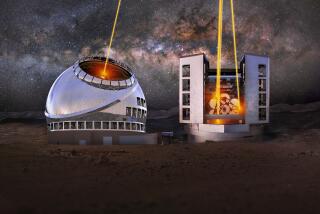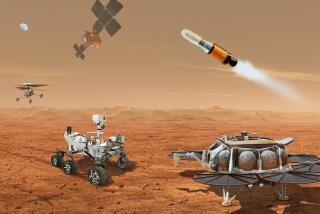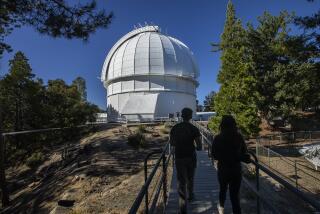NASA Orders a Powerful New Space Observatory
TRW Inc. was selected by NASA on Tuesday to build a new space telescope, a high-profile scientific project that represents an endorsement of Southern Californiaâs leadership in the space industry.
The new observatory--to be 10 times more powerful than the existing Hubble Space Telescope it will replace--will allow astronomers to peer deeper into the cosmos than ever before.
Scientists hope to use the capability to understand what happened after the big bang that created the universe.
TRW engineers have designed a telescope that will orbit the sun about a million miles from Earth. Rather than a single mirror, the new telescope will have 36 mirrors forming a single 20-foot-diameter array.
Although the $825-million contract is not large by aerospace industry standards, it is among the most prestigious programs in the space business. TRW would build the telescope at its Redondo Beach plant, which has 9,000 employees.
âBesides the space station, itâs probably NASAâs biggest scientific project for the next 10 years,â said Marco Caceres, senior space analyst for Teal Group, an aerospace research firm in Fairfax, Va.
In the last three months, TRW has won three major satellite programs and in recent years other Southern California firms have several awards that have further solidified the regionâs role in the space industry.
The importance of the TRW award is reflected in the achievements of the Hubble, launched in 1990 into an orbit 375 miles above Earth.
It has provided stunning photographs of galaxies and insights into the beginning of the universe.
TRWâs next-generation space telescope is expected to replace Hubble by 2010 and provide what scientists hope will be clues to how galaxies formed.
In awarding the contract, NASA officials named the telescope after James E. Webb, who directed the Apollo missions that eventually landed the first astronauts on the moon.
TRW beat Lockheed Martin Corp. for the contract. The entire program is expected to cost $1.3 billion, including future contracts for electronic sensors.
NASA hopes to keep the cost well under the $2-billion price tag for Hubble, which has operated for 12 years and is expected to last 10 more years.
The telescope is designed to last five years, though NASA hopes to be able to extend its lifespan.
The company anticipates hiring 400 engineers for the project.
In the last year, TRW has won several major government contracts.
Two weeks ago, the company won the largest satellite production contract in its history, a $6.5-billion program to build a new fleet of primary weather-monitoring satellites for joint military and civil use.
Just a three months earlier, the Pentagonâs Missile Defense Agency selected TRW to oversee a $6-billion satellite system to track enemy ballistic missiles.
âThis is probably one of TRWâs best years ever,â Caceres said. âI canât recall a year where they have won so many major contracts in a relatively short time, and theyâve basically beaten the industry leaders in doing it.â
Cleveland-based TRW is in the process of being acquired by Northrop Grumman Corp., which has its headquarters in Century City.
The TRW contracts add to work underway at Boeing Co. facilities in El Segundo and Seal Beach where the company is developing supersecret spy satellites for the Pentagon, which intelligence analysts estimate could be worth up to $25 billion over two decades.
Boeingâs El Segundo complex is the worldâs largest commercial satellite maker.
In addition to TRW and Boeing, NASAâs Jet Propulsion Laboratory in Pasadena produces the nationâs deep space probes.
Aerospace analysts said the TRW project is âpushing the scientific envelop in several different ways,â including placing a spacecraft in a permanent orbit around the sun.
After its launch on an expendable rocket, probably Lockheed Martinâs new Atlas V, the spacecraft will take three months to reach its destination about 940,000 miles from Earth.
Positioned at so-called second Lagrange Point, the spacecraft will be able to literally hover in space, balanced between the gravity of the sun and Earth.
Once in position, the spacecraft will unfurl a sun shade about the size of a tennis court.
A fiber shield will protect the mirrors from the light and heat of both the sun and the Earth.
The infrared sensors will be cooled to very low temperatures without the use of complicated refrigeration equipment, NASA said.
âItâs not like Hubble at all,â said Charles Vick, chief space policy analyst for the Federation of American Scientists. âThe design approach is very, very unique, and frankly I donât comprehend it myself.â
Shielded from light, the telescope will be able to detect with more precision and clarity the first objects to emerge after the big bang, NASA said. Some of the objects date back 12 billion to 13 billion years but astronomers arenât quite sure what these objects might be.
Even though the Hubble telescope is a significant improvement from earthbound observatories that are hindered by the atmospheric distortion, it has been unable to see the earliest objects.
And although the Hubble is now considered an important contributor to astronomy, it wasnât without major problems in its early days. The first images it sent back to Earth were fuzzy because its mirror had been improperly ground and polished.
Since 1993, space shuttle astronauts have worked on the Hubble four times. While the Hubble cost about $2 billion to develop and launch, analysts believe an additional $4 billion has been spent operating and repairing it.
By contrast, TRWâs telescope positioned so far from Earth could not be repaired if something goes awry, raising some anxiety among NASA watchers. âWe are not going to have manned access to do the repairs and the refurbishment like we did with the Hubble, which is a serious issue,â Vick said. âA lot of people are going to be chewing their fingernails.â
TRW executives are a bit more confident, citing their experience developing other successful spacecraft including the Chandra X-ray Observatory and the Compton Gamma Ray Observatory. But they acknowledge the challenge of the telescopeâs design.
âItâs pretty stunning what this mission will do compared to the Hubble,â said Tim Hannemann, chief executive of TRWâs Space & Electronics unit in Redondo Beach. âThis will be a real breakthrough.â
More to Read
Inside the business of entertainment
The Wide Shot brings you news, analysis and insights on everything from streaming wars to production â and what it all means for the future.
You may occasionally receive promotional content from the Los Angeles Times.










